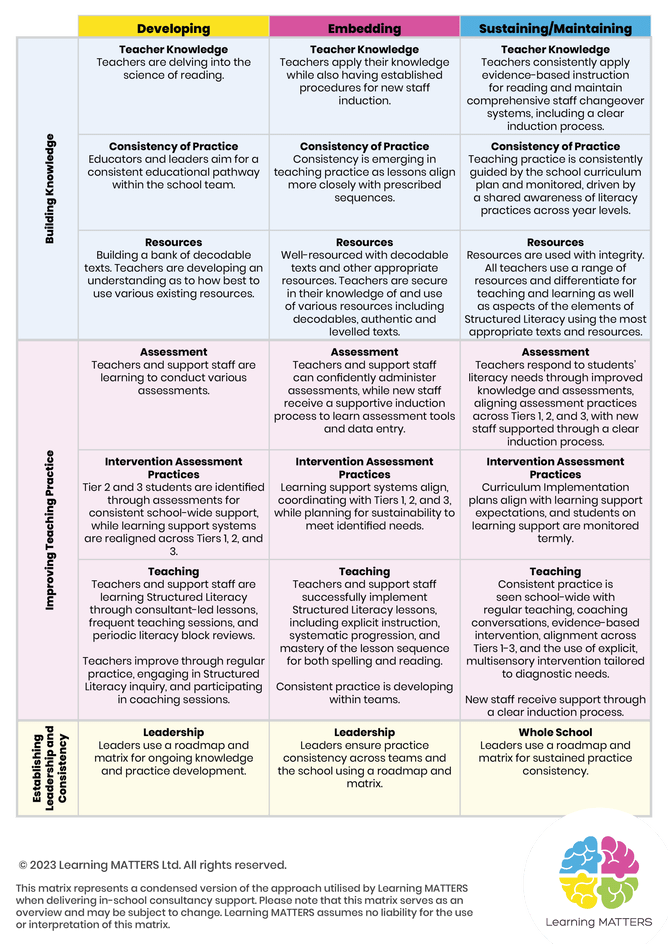Structured Literacy is an evidence-based approach to teaching foundational reading skills. It bridges the gap between the science of reading and practical classroom application by emphasising systematic, explicit, and sequential teaching. Integrating an approach that is guided by the principles and elements of Structured Literacy into school curriculums is a significant step towards ensuring that all students possess a robust reading foundation, positioning them for academic achievements.
Far too often, there is a misconception regarding the implementation of a Structured Literacy approach, with some perceiving it as a rigid programme that restricts teachers' autonomy and choice. It's crucial to understand the importance of building consistent knowledge, consistent practice, and the availability of resources, when endeavouring to increase literacy rates in our kura.
It is far more than a checklist; think of this as constructing an educational state highway, directing the traffic with considered stop-and-gos (to check for understanding) to reach a main destination of maintaining this approach.
At times teachers may veer off the main educational state highway, and this flexibility is perfectly acceptable. However, if there was no common highway to veer from or come back to, then we end up going in all different directions (based on various bodies of knowledge and beliefs). A consistent, evidence-based educational pathway is what all teachers and their students deserve.
This educational highway serves as a reliable guide, ensuring that we ultimately reach our intended destination to the best of our abilities.
This blog explores the essential elements to consider when developing, embedding, and ultimately sustaining and maintaining this approach in your school.
Professional Development: A great place to initiate your journey would be equipping teachers with knowledge of how the brain learns to read, along with comprehensive professional development that fosters a deep understanding of phonology, phonics, morphology, syntax, and semantics — vital foundations for effective instruction.
If you’re looking for a place to start building your knowledge, we’ve had some incredible conversations over the years with experts in literacy and education via our Chit Chats.
Curriculum and Instruction: Review existing curriculum implementation plans to ensure they reflect evidence, new knowledge, and evolving shifts in practice. Implement a well-structured scope and sequence that is systematic and cumulative with a logical progression while employing multisensory techniques that engage multiple modalities simultaneously (auditory, visual, and kinaesthetic learners).
Teacher Knowledge and Consistency of Practice: Explicitly plan and teach the following elements of a Structured Literacy approach. Enable teachers to develop knowledge through practice and improvements in instruction. Confidence and capability will increase over time. Embedding this into local school curriculum plans ensures teachers have direction, know what is expected of them, and there is consistency of an educational pathway developing across the year levels.
Resources: Establish a robust pool of resources that encompass the elements above and align to the comprehensive scope and sequence. These resources should include a variety of decodable texts and incorporate activities designed to foster fluency and promote vocabulary-building throughout the primary school years (and beyond where required).
Progress Monitoring and Assessment: Establish a system for continuous progress monitoring, which assists in identifying students in need of additional support and helps guide instruction. Use valid and reliable assessments to measure student growth and target areas for improvement.
Intervention and Differentiation: Use data to drive resourcing decisions regarding intervention allocations. Consider systems and processes in place for allocations and how consistent and moderated these are across year levels. Personalise interventions for students requiring extra support and differentiate instruction according to identified individual student needs and skill levels.
Collaboration and Support: Foster a culture of learning, communication and collaboration among teachers, administrators, and support staff. Be sure to lean into challenges just as much as you do successes. The challenges are what help us to really reconsider our practice and processes. Work to ensure there is a developing consistency in implementation and support for teachers. Just like our students, our teachers have different needs. Additionally, provide resources and support for parents to reinforce Structured Literacy practices at home.
Continuous Improvement: Regularly review and evaluate the effectiveness of the implementation of a Structured Literacy approach. Have a well-structured roadmap in place. Carefully consider and plan the focus for each term, such as:
Identifying new knowledge and practices to implement. What will you be reviewing and monitoring through classroom observations and staff meetings from previous new learning, and what leadership actions are necessary to ensure progress is occurring?
Determining what aspects will be reviewed and monitored through classroom observations and staff meetings, building upon previous new learning.
Identifying necessary leadership actions to ensure that progress aligns with the established roadmap.
Feedback from teachers, students, and parents to identify areas for enhancement and make necessary adjustments.
Implementation of a Structured Literacy approach should be tailored to meet the specific needs of your students and the context of your school. Regular assessments, ongoing professional development, and a steadfast commitment to evidence-based practices are vital for successful implementation.
Where are you on your journey? Are you constructing that educational state highway for your teachers and students, or are there aspects that require further development? Remember, a Structured Literacy approach not only lays the foundation for reading success but also provides a teaching approach that leads us into teaching the more complex aspects of language, such as morphology, syntax, and semantics. Let's not fall into a novice trap, thinking it is only for juniors.









